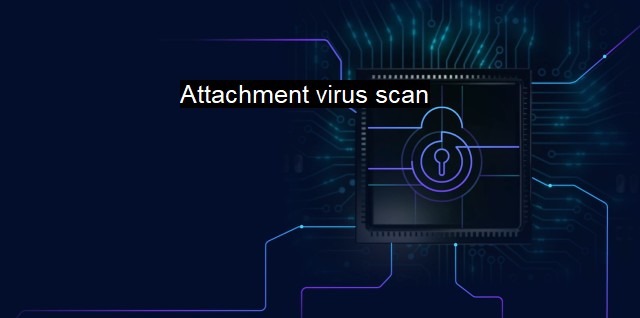What is Attachment virus scan?
Preventing Cybersecurity Threats: Understanding Attachment Virus Scans and Why They are important for System Protection
The phenomenon of "attachment virus scan" takes due place in the context of cybersecurity and antivirus protection software specifically. an attachment virus scan reflects the process employed by antivirus software to examine and analyze email attachments or files that users download from the web, all in a bid to identify potential malware, viruses, and cyber threats before they find their way into your device or system. It is an integral part of a robust cybersecurity system because email attachments and downloaded files field the most common hideouts for cyber threats to breach our systems.The advantage of having an attachment virus scan is primarily the early identification of lurking malware. For instance, a disguised innocent looking .PDF file may have malicious code embedded deep within its complexities. The unwary user might download and open this file to invite a malware attack inadvertently. The attachment virus scanning mechanism notifies the user of such risks in the initial stages itself.
Virus scanning can take place at both the email client and server levels. Larger corporations especially employ server-level scanning to trap viruses before they ever near the workstation of individual employees. This proactive approach to cybersecurity safeguards the enterprise from potentially catastrophic malware outbreaks.
An attachment virus scan not only isolates detrimental software but also leverages system heuristics to discern unrecognizable or newly popping malicious codes. Virus definitions keep updating as cyber threats keep evolving; a strong attachment virus scan versus just an antivirus helps keep pace with this evolution. By analyzing code behavior and detecting unusual actions in applications, heuristics magnify the chances of uncovering sneaky viruses hidden deep within extensions of known, reliable software.
Such security screenings are not downright infallible. Cyber attacking techniques and malware writing can become more ingenious with passing time. These virtual evils are created to elude the security scans or even silently deactivate antivirus protocols. Still, the efficiency of attachment virus scans continues to be noteworthy, and they present a considerably helpful first line of defense against cyber-attacks.
Focused attachment virus scans are a necessary extension of conventional scanning. Software development kits (SDKs) facilitate the smooth integration of antivirus with versatile platforms like web servers, cloud platforms, email clients, etc. The scanning mechanism checks attachments per preset parameters before letting the end-user access or download them.
In addition to simplicity, an attachment virus scan provides comprehensive results, swiftly identifying threats, classifying them, and creating logs for auto or manual cleanup. It also contributes to increased awareness about spear phishing, deceptive or harmful emails, and potentially unethical, dubious contents slipped into attachments.
Amidst a soaring graph of cyber breach incidents and increased remote work sequences,the necessity for facing evolving cyber threats with nearly military precision cannot be accentuated enough. As such, ensuring an efficient antivirus mechanism fortified with due attachment virus scan protocols and tools is of vital importance in promoting safe digital connectivity and vigilant user behavior.
Attachment virus scanning also says much about the pace and progress of how we look at cybersecurity today. From generic scanning protocols, we have moved to specifically focusing on vulnerable areas such as email attachments, rendering the security shield undeniably comprehensive. Besides its role in the grander template of cybersecurity, attachment virus scanning could additionally help put a range on cyber threats, making it a truly worthy inclusion to any safety-first cybersecurity strategy.
An attachment virus scan should not be perceived alone. It is to hybridize with safe browsing, secure infrastructure, optimal network designs, and cybersecurity awareness among society—the team functions are at play: timely updates, scans, and awareness of the environment can collectively help to outrun cunning cyber threats.

Attachment virus scan FAQs
What is an attachment virus scan?
An attachment virus scan is a cybersecurity measure that scans email attachments for malware or viruses. This helps prevent the spread of harmful software and protect computer systems from potential attacks.How does an attachment virus scan work?
An attachment virus scan works by analyzing the file types and contents of email attachments. The software looks for known virus signatures and suspicious behavior, such as attempts to access sensitive files or communicate with external servers. If a virus or malware is detected, the attachment is blocked or quarantined to prevent it from infecting the recipient's computer.Do all antivirus programs include attachment virus scanning?
Most reputable antivirus programs include attachment virus scanning as a standard feature. However, it's important to check that your chosen software includes this functionality, especially if you frequently use email to share files.Can an attachment virus scan detect all viruses and malware?
While an attachment virus scan can detect many known viruses and malware, it's not foolproof. Hackers are constantly developing new tactics to evade detection, so it's important to use other cybersecurity strategies, such as keeping your software up-to-date and avoiding suspicious emails and attachments.| | A | | | B | | | C | | | D | | | E | | | F | | | G | | | H | | | I | | | J | | | K | | | L | | | M | |
| | N | | | O | | | P | | | Q | | | R | | | S | | | T | | | U | | | V | | | W | | | X | | | Y | | | Z | |
| | 1 | | | 2 | | | 3 | | | 4 | | | 7 | | | 8 | | |||||||